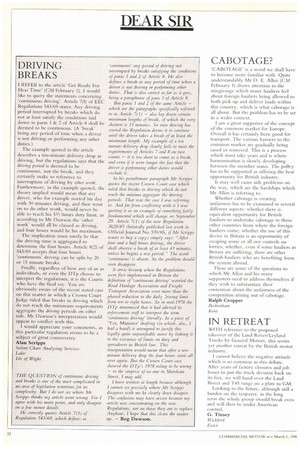Ti Q t 'I ION at continuous driving ami breaks is One of the most complicated in
Page 32

If you've noticed an error in this article please click here to report it so we can fix it.
ar,"%: of legislation notorious Pr its Walphi'xity, Ma I do not see where Mr Sz ripp., thinks my article went wrom,,. For I agree u,ith his ((lain paint, and citify disagree on a jai, minor details.
He correctly quotes Article 7(1) of Regulation 543/69, which defines as
'iownneons. any period of driving not interrupted by breaks satisfying the conditions paras 1 and 2 of Article 8. He also defines a break as any period of time 0101 a driver is not driving or perfimning other thities. That is also correct as j'ar as it .qtys, being a paraphrase of pant 3 of Article 8.
But paws 1 and 2 of the same Article — which are the paragraphs specifically referred to in Article 7(1) — also lay down certain minimum lengths of break, of which the very shortest is 15 minutes. So once driving has started the Regulation deems it to continue until the driver takes a break of at least the minimum length. My example of a ten minute delivery drop dearly fails to meet the requirements of Articles 7 and 8 on two counts — it is too short to count as a break, and even if it were longer the .ha that the driver is perfOrming other duties would exclude it.
In his penultimate paragraph Mr Scripps quotes the recent Crown Court case which ruled that breaks in driving which do not reach the minima aggregate the driving periods. That was the case I was referring to. And .fetr.from conflicting with it I was quoting it as an example of somethingjairly fundamental which will change, on September 29. Article 7(1) of the new Regulation .3820/85 (belatedly published last week in Official journal No 370/85, if Mr Scripps wants to buy a copy) simply says: "Afier four and a half hours driving, the driver shall observe a break of at least 45 minute's, unless lw begins a rest period." The word 'continuous' is absent. So the problem should soon disappear.
Ii arose because when the Regulations were first implemented in Britain the definition of 'continuous driving' worried the Road Haulage Association and Freight Transport Association even more than the phased reduction in the daily .!riving limit _from ten to eight hours. So in mid-1978 the 1) '1 announced that it had advised its enforcement staff to interpret the term 'continuous driving' literally. In a piece of 'Yes. Minister' drafiing tin which, alas, had a hand) it attempted to justify this legally quite entjustiliable move by linking it to the existence of limits on duty and yreadover in British law. This interpretation would mean that after a tettminute delivery drop the .finer hours starts all over again. But the Crount Court case hoic,c,ci the DTp's 1978 ruling to be wrong
to the surprise t>/no one in :Worsham Street, I may add.
I have written at length because although I cannot or precisely where Mr Scripps disagrees with me he dearly does dis,N,c,•. The cottlitsion may have arisen because my atti, le was CanCentratIng On the new Regulations, not on those they are to replace.
A uyii , hope that this clears the matter — Reg Dawson.




























































